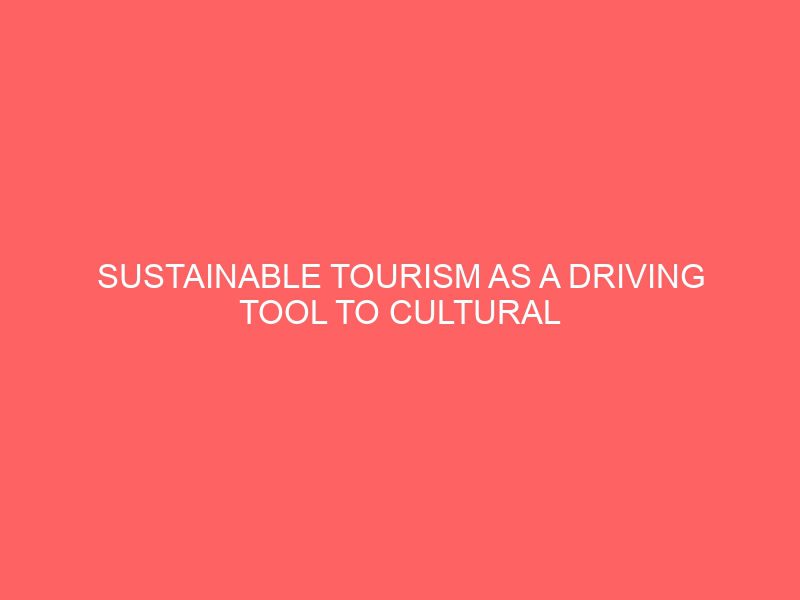Description
ABSTRACT
The purpose of this research work is to find out the role of sustainability for the development of cultural heritage sites development. It was mainly targeted to know the importance of cultural heritage in tourism industry and its impact and ways to develop sustainable tourism in those sites. The case study of Imoleboja Rock shelter was taken as the research project to analyze and interpret the significance and process of sustainability.
The research work suggested that tourism in cultural heritage sites development should ensure three pillars of sustainability: environmental sustainability, sociocultural sustainability and economic sustainability for the longterm success and development of cultural and heritage tourism. The world heritage sites were taken as important part of cultural heritage to define the importance of cultural heritage in tourism industry. The research work explained the need of active involvement of local people, tourism operators, government and nongovernment organizations for the preservation and promotion of cultural values, heritages and traditions.
On the case study of Imoleboja Rock the research revealed that Imoleboja Rock is one of the significant places for humankind. It was found that Imoleboja Rock needs an urgent sustainable tourism management plan to monitor and implement the development activities. The study also revealed that the participation of the local people and concerned organizations in safeguarding the cultural assets of Imoleboja Rock was insufficient. The study suggested that sustainable business practices should be adopted and implemented in this particular site for its feasible development.
CHAPTER ONE
1.0 INTRODUCTION
Cultural Heritage in South East Africa is very impressive. The legacy of thousands of years of history has not only left material traces, such as historic buildings or characteristic architectural features dry stone walls, chapels, fountains, vernacular buildings EC 2002 , but also a wealth of immaterial culture, be it customs, folklore, knowhow, handicrafts, culinary specialties, music, dance and others. Almost every village has its own distinctive heritage, which not only identifies it, but also differentiates it from neighbouring villages.Sustainable tourism is introduced as a major field of research in the tourism industry. The evergrowing number of tourists in cultural and heritage tourism has exposed threats in maintaining the economic, social and environmental aspects of the cultural heritage sites. Globalization, urbanization and climate change have adversely affected the quality of the resources found in those sites. The longterm success of tourism development in cultural and heritage tourism needs an urgent sustainable change for the proper management of the socioeconomic and ecological development.
Cultural and heritage tourism is the fastest growing sector in the tourism industry. Cultural heritage sites and places reflect a large and varied collection of the human creation and history of the culture adopted across the entire world. It includes cultural aspects such as heritage sites, monuments, traditional activities, languages and natural resources that are considered very important to be preserved for the future generations. The heritage sites are popular destinations for the tourists who are curious and dedicated to explore historical, cultural and archaeological sites and intend to interact and get to know the local community as well. Due to the increased curiosity in people to learn and experience other cultures and communities, a large number of people are travelling across the world. The increasing trend of tourists in this sector of tourism has increased the living standard of the local people by creating job opportunities and enhancing the local cultures and traditions.
On the other hand, tourism has negative impacts as well. Tourism can create conflicts between the tourists and the local people and the stakeholders involved in the sector. There may arise insecurity in cultural diversity and economic and environmental degradation.
Therefore, there is always a need of sustainable development process to identify, manage and conserve the heritage values through understanding the impact of tourism towards the communities, ensuring the socioeconomic benefits and providing financial supports for the protection of the resources and promotion of the places.
1.1 BACKGROUND OF THE STUDY
Cultural and heritage tourism is a sector of tourism that includes the travelling experiences of historical, cultural and natural resources that reflect the authentic stories and facts related to the people from the past and present. The tourism sector involved with the cultural and heritage values gives the tourists a significant number of opportunities to understand an unfamiliar place, people and time. The importance of the heritage value increases with the arrival of people to that place which in turn has created new possibilities for preservation of the sites. Cultural and heritage tourism contributes growth in economic strength of the local people providing new job opportunities and promoting local cultures and values. National Trust for Historic Preservation 2011.
The majority of south east African countries have made considerable efforts to inventory and conserve their built heritage. At international level, unique and outstanding examples are recognized through their nomination as a World Heritage site under the auspices of UNESCO. In Africa there are now over 962 such sites listed, among them 745 Cultural sites in the UNESCO record 2013, so there are no doubts that this immense heritage has the ability to attract tourists, not only to the actual sites but also to the surrounding area.
The idea of this publication originated from a discussion within the CHERPLAN Steering Committee meeting in Montenegro. Participants noted that all the involved pilot project sites present a common HitandRun Tourism problem, with tourists visiting the site for few hours to continue their travel to other destinations with more attractive accommodation and recreational facilities. This type of tourism generates mainly negative impacts on the heritage sites dealing with increased waste generation, water consumption and traffic while the income is almost absent. Daily mass tourism in the area of Hallstatt for example involving tens of buses per day has a high environmental impact on the territory. In discussing HitandRun Tourism, we need, however, to consider how a sustainable tourism can be achieved in the Cultural Heritage sites. In addition, Cultural Heritage CH is not seen as an overall priority for national development unless its relationship with social values, economic activities and local development is made clear. This kind of tourism constitutes an essential engine for economic development, where the major measurable economic impacts of CH include: job opportunities and household income; centre city revitalization; stable property values and small business incubation. In Africa revenues generated by cultural tourism are most significant: 79 of the turnover in Africas Cultural Heritage sector is tourism related, while 16 is derived from maintenance investments by private owners, charities, and foundations Archimede Programme with the remaining 5 coming from public and governmental bodies. It is evident that heritage is a driving force for development of tourism industry in our cities.
According to recent estimates, more than 8 million jobs are directly and indirectly sustained by the Cultural Heritage sector in Africa. Nevertheless, in this period of economic recession most national governments decided to cut the budget dedicated to this important sector.
1.2STATEMENT OF RESEARCH PROBLEM
For the abovementioned reasons, it is necessary to find appropriate solutions which, on one hand increase the number of tourists and in particular the overnight stay in order to strengthen the revenues from the tourism sector, and on the other hand adopt an environmentally friendly strategy to preserve the value and beauty of the natural and cultural heritage.
1.3OBJECTIVES OF THE STUDY
The main aim of this research work is to find out the role of sustainable tourism for the development of cultural heritage sites through a case study of IMOLEBOJA ROCK in Kwara state. This research work is also aimed to analyze the participation of various independent actors in developing sustainable tourism. The ultimate objective of this research work is to provide further suggestions and recommendations for planning, implementing and monitoring the sustainable tourism development in Kwara state, as well as other.








Reviews
There are no reviews yet.